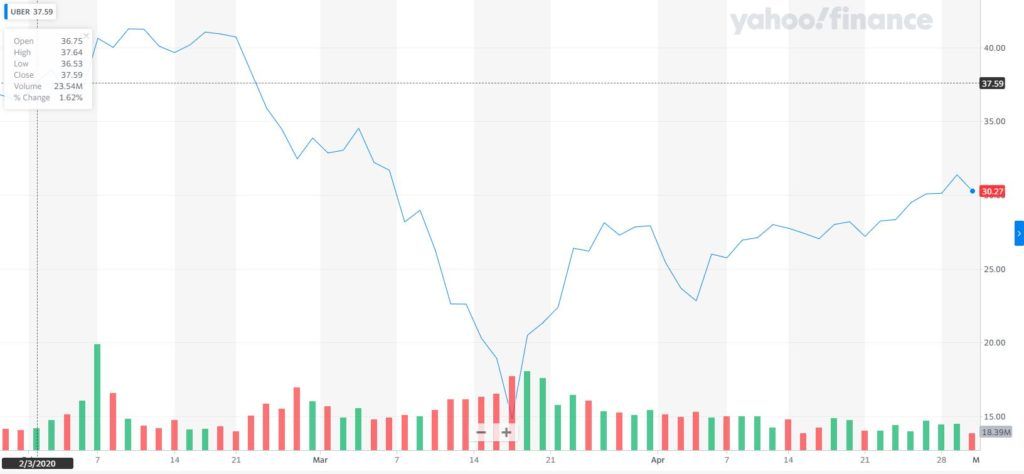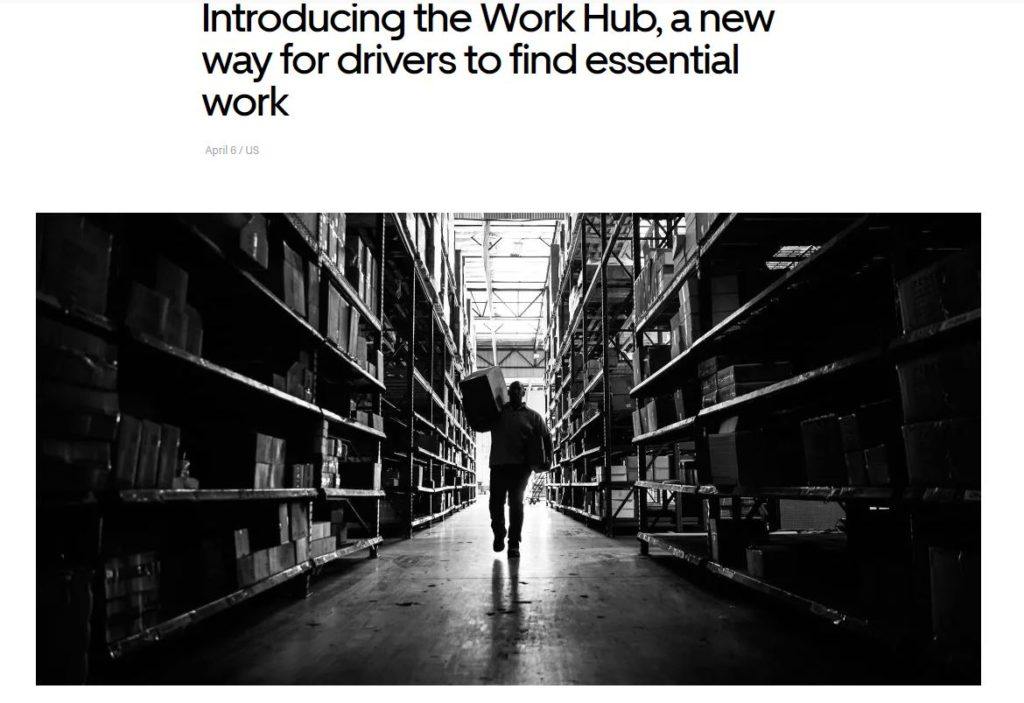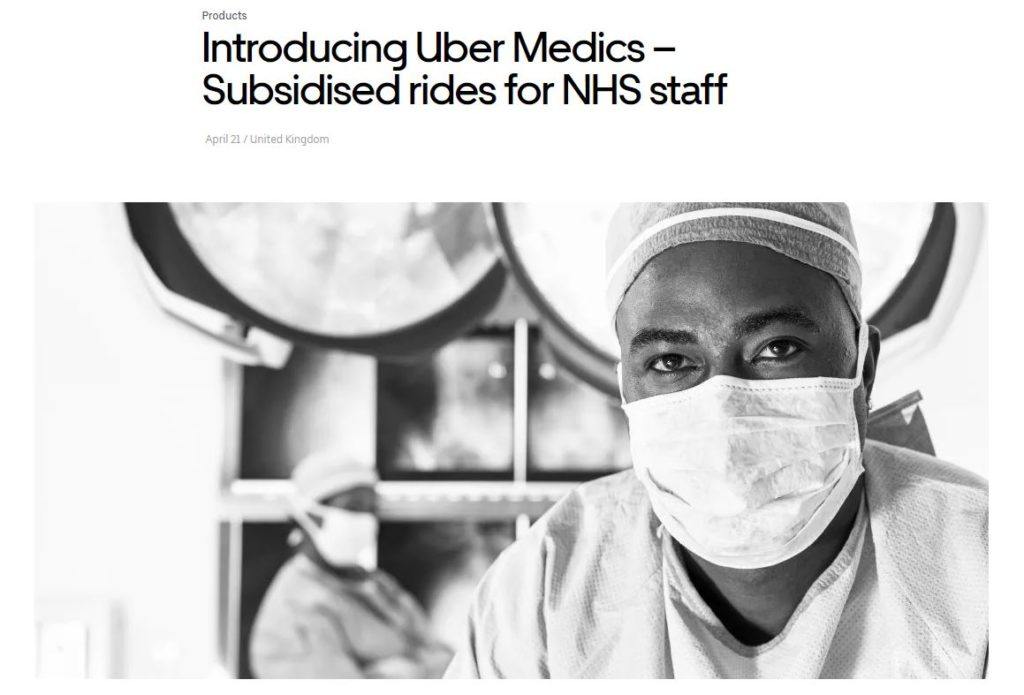Uber Medics and Uber Work: Limitless opportunities for Uber?

While ride-sharing faces a huge decline, Uber has managed to keep its head above water through innovating new services.
Following a steep decline in ridership on its ride-hailing platform, Uber stocks fell by 17.6% in March[i]. In fact, it is estimated that ride-hailing has dropped by nearly 94% since the beginning of March.[ii] However, Uber has seen its share prices steadily rise again over the past few weeks. While their financial performance may still be under threat, Uber has undeniably become part of the ‘frontline’ in this pandemic, and they appear to be doing relatively well. How have they responded to this crisis, and what has enabled them to do so?
Uber share price from Feb 1- April 30 2020. Lowest point on March 18th.
(Source: Yahoo Finance)
Uber at the frontlines of COVID-19 through diversification
Needless to say, while Uber’s ride-sharing platform has seen a sharp decrease in demand, it has seen a rise in demand for Uber Eats, its food delivery service. With lockdowns and social distancing measures in place, and strong support for local restaurants, it is no surprise that demand for food delivery has increased. In March, Uber Eats experienced a surge in sales as well as a 30% increase in customers signing up for the service and drivers. [iii] In addition to the usual food deliveries from restaurants, Uber has announced partnerships with grocery and convenience stores, such as with the supermarket chain Carrefour in France, and convenience store Galp in Spain[iv].
Moreover, Uber has expanded its services to help its drivers during these challenging times. For example, it launched Work Hub, a platform to enable Uber drivers to find alternative gig work. It builds on its existing platform and connects drivers to three other Uber platforms: Uber Eats, Uber Freight for trucking, and Uber Works for temporary shift-based jobs. Through Uber Works, drivers can find temporary work in customer service, food production, and logistics, to name a few. Moreover, Uber has partnered with companies such as McDonald’s, PepsiCo, UPS, and Walgreens to enable them to hire through its system.[v] This marks a significant widening of its service provisions.
Work Hub acts as a platform for Uber drivers to find alternative gig work
Source: Uber’s official blog
Furthermore, Uber has launched Uber Medics, to provide free and discounted rides to health care workers to and from patients’ homes and to medical facilities. It has been rolled out in over 20 countries including Spain, India, France, and Germany. In the UK, Uber has been providing 200,000 free rides and 100,000 free meals for NHS (National Health Service) staff.[vi] Uber drivers are allowed to opt-in to Uber Medics, and are guaranteed the full fare. This suggests that Uber is committed to protecting its drivers (financially) during this downturn, although it may come at a financial loss to the company.
Uber Medics has been rolled out in over 20 countries
Source: Uber’s official blog
Focus on ‘Moving what matters’
Uber has several key capabilities and processes that have allowed them to weather this storm and became an essential part of the fight against Covid-19. Firstly, it has a deep understanding of what its core capabilities and assets are. Instead of narrowly defining itself as a ride-sharing platform or a food-delivery platform, Uber sees itself simply as ‘moving what matters’. [vii] Moreover, it understands that their competitive advantage lies in its technology and data platforms; integration of critical infrastructure across different platforms; and its networks of drivers and end-users. Taken together, Uber understands that they are simply in the business of connecting people to places and other people using technology. This has allowed Uber to reimagine how they can use its existing platform to adjust to changing supply and demand requirements that we see during this pandemic. WorkHub is a clear illustration of this. Uber is quickly transforming itself into a general online platform for all gig economy workers, leveraging its key capabilities in connecting, organizing, and routing.
Building trust through transparency and speed
Secondly, the transparency and speed with which Uber has implemented these changes have been impressive to say the least. Following the outbreak of Covid-19 in the US, it quickly stopped all ride-sharing in mid-March before the nation-wide lockdown. For UberEats delivery, they’ve mandated a ‘leave at door’ policy around the same time. Uber Medics was set up in March soon after a request was initially made by the Spanish health authorities.[viii] Moreover, it was quick to announce a paid leave policy for all of its contract workers. Although the efficacy of this policy has been questioned and problems abound[ix], it was a stark break from its previous indifference to the plight of its drivers. A quick look at their website, and you can see the clear and frequent updates on their Covid responses as well as communication to their drivers and safety precautions taken to assuage end-customers. All these measures highlight that Uber realizes that transparency and speed are critical in developing and retaining trust between the company and its customers on either side of the platform.
Importance of Creating Public-Private Partnerships
Lastly, Uber has taken this opportunity to forge strong public-private partnerships (PPP). In fact, this pandemic has highlighted the importance of social innovation from the privates sector to tackle societal problems. Uber is in close coordination with local, state, and provincial governments around the world to deliver and provide meals, medications, and other essential goods.[x] Tech companies that have been able to work closely with public authorities to offer assistance during this crisis, from telehealth to Edtech, will likely see significant long-term growth, even after the pandemic.
Short-term headwinds but longer term gains?
Despite its dramatic decline in its core business in ride-hailing/sharing, Uber appears to be able to weather the storm to a certain degree through its diversified businesses. The networks, operational capabilities, and the public goodwill they have developed through this crisis will certainly help them in the longer term. They have been able to do this thanks to a solid understanding of their key competencies, acting with transparency and speed, and developing public-private partnerships. While they may continue to suffer financial losses, they have certainly become a critical part of the infrastructure to tackle Covid-19.
Sources
[i] Parkev Tatevosian, Uber Stock Fell 17.6% in March, Nasdaq, April 5 2020. https://www.nasdaq.com/articles/why-uber-stock-fell-17.6-in-march-2020-04-06
[ii]Simon Chandler, Coronavirus turns Uber into Gig Platform for All Work, Forbes, April 7 2020 https://www.forbes.com/sites/simonchandler/2020/04/07/coronavirus-turns-uber-into-gig-platform-for-all-work/#19317a6b1db9
[iii] Marco Chiapetta, Uber Eat Demand Soars Due to Covid-19 Crisis, Forbes, March 25 2020 https://www.forbes.com/sites/marcochiappetta/2020/03/25/uber-eats-demand-soars-due-to-covid-19-crisis/#2858c975580c
[iv] Uber ‘Supporting our Communities’ webpage https://www.uber.com/newsroom/supporting-our-communities/
[v] Simon Chandler, ibid.
[vi] Uber Offers Discounted Trips to 2.5 million UK health and care workers, Reuters, April 27 2020. https://economictimes.indiatimes.com/small-biz/startups/newsbuzz/uber-offers-discounted-trips-to-2-5-million-uk-health-and-care-workers/articleshow/75403456.cms?from=mdr
[vii] Uber ‘Coronavirus’ webpage https://www.uber.com/us/en/coronavirus/
[viii] Reuters, ibid.
[ix] Jacey Fortin, A Quarantined Uber Driver’s Quest for Paid Sick Leave, The New York Times, April 4 2020. https://www.nytimes.com/2020/04/04/business/coronavirus-uber.html
[x] Uber webpage, ibid.






This was very interesting Kumiko! I wonder what you think about the future of these programs and if they present a separate business for Uber? For example, Uber Medics could potentially become a platform for healthcare businesses’ transportation needs. The same model can be extended for other sectors where people move around a lot and can this potentially come with service level guarantees?
In a post-Covid world, I am very curious to see how Uber’s main rideshare business will fare, particularly their innovations around Pool that were designed for more utilization. My intuition suggests that people would want fewer shared rides but on the flip side, perhaps more people would demand Uber rather than use public transportation?
Thanks for the post, Kumiko! I did not know about Uber’s Work Hub initiative. It sounds like a great idea. However, I would be interested in knowing the actual number of people who have found alternative jobs through this. At this time when unemployment is so high and the number of gig workers had grown so much prior to Covid, I would imagine that there is a surplus of workers and deficit of jobs. So despite making the connections, most people are still rendered jobless at this time. Would love to know more about your thoughts on this. Thanks!
Great article! I didn’t know about the Work Hub and Uber Medics, I think they are great initiatives. I agree speed and transparency are key to build trust and it would be a great opportunity for Uber to improve its reputation with the public sector.